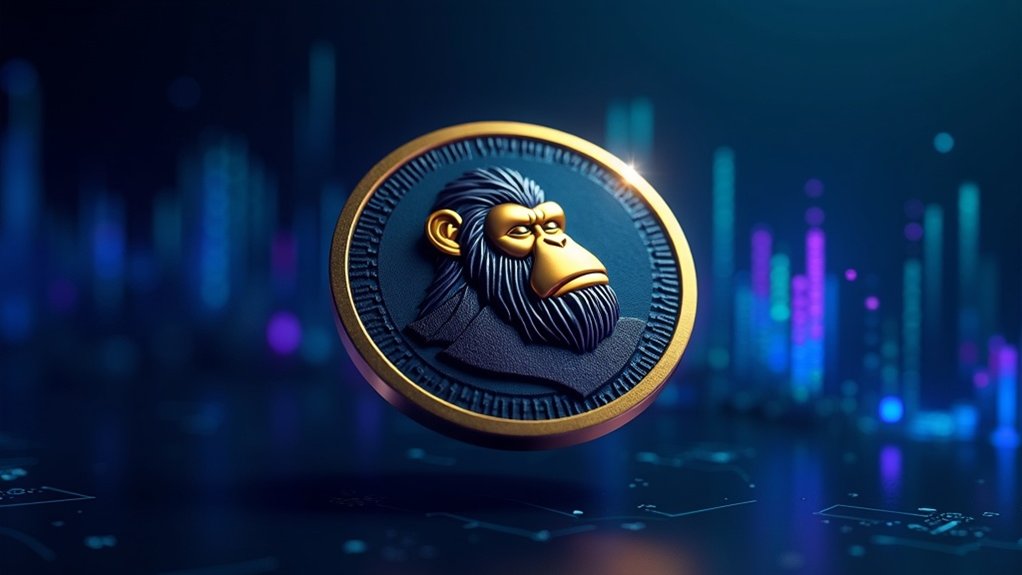ApeCoin (APE) is an ERC-20 token launched in March 2022 by Yuga Labs, creators of those ridiculous Bored Ape NFTs. It’s not just another meme coin, though. APE serves as a governance token for the ApeCoin DAO, grants access to exclusive events, and functions as currency in the Otherside metaverse. With a fixed supply of one billion tokens, it experienced wild price swings after launch. The crypto community’s playground money has some actual utility. Shocking, right?
The digital revolution has a new player in town. ApeCoin (APE) burst onto the crypto scene in March 2022, an ERC-20 token created by Yuga Labs – yeah, the same folks behind those ridiculous ape pictures selling for millions. But don’t roll your eyes just yet. This isn’t just another meme coin.
APE serves dual purposes as both governance and utility token within the Ape ecosystem. Holders get voting rights in the ApeCoin DAO, deciding everything from fund allocation to partnerships. Democracy in action, crypto style. The Ape Foundation handles the boring part: implementing whatever the community votes for.
With a fixed supply of one billion tokens, APE launched with a bang. About 30% hit circulation immediately, with Bored Ape and Mutant Ape NFT holders receiving generous airdrops. Lucky them. Major exchanges listed APE simultaneously, generating $2.3 billion in volume on Coinbase alone within a week. Talk about making an entrance. Like other fungible tokens, each APE token is identical and holds the same value as any other APE token.
Price volatility? You bet. APE swung wildly between $40 and $7 shortly after debut. Not for the faint-hearted investor.
What’s it actually good for? More than you’d think. APE grants access to exclusive events and merchandise. Some merchants accept it for payments. It powers play-to-earn mechanics in games like Benji Bananas. And it’s set to become the currency of choice in Yuga Labs’ metaverse project, Otherside. The token also supports the development of ApeChain blockchain which offers lower transaction costs and faster processing times. Practical utility, imagine that.
The token operates on Ethereum using standard ERC-20 protocols and smart contracts. Nothing fancy on the technical side. No minting or burning mechanisms exist – what you see is what you get. You can securely store your ApeCoin using hardware wallets like Ledger or Trezor for maximum protection.
APE represents an interesting cultural convergence, bridging NFT culture with cryptocurrency functionality. It’s positioned as fun money for the digital playground, backed by Yuga Labs’ reputation and a $450 million funding round. Will it last? Who knows. But in the wild west of crypto, ApeCoin has certainly claimed its territory.
Frequently Asked Questions
How Volatile Is Apecoin Compared to Other Cryptocurrencies?
ApeCoin exhibits moderate volatility at 7.7-7.8%, falling between major cryptocurrencies and smaller altcoins.
It’s more volatile than Bitcoin or Ethereum (typically 3-5% in stable periods), but less erratic than micro-cap tokens.
APE shows sharp reactions to NFT and metaverse news.
With price swings reaching 20% and trading volume fluctuations of 40%, it’s definitely not for the faint-hearted.
The “Greed” sentiment score of 69 suggests emotional trading drives its movements.
What Unique Risks Are Associated With Investing in Apecoin?
ApeCoin carries distinctive risks beyond typical crypto volatility.
It’s heavily dependent on BAYC’s cultural relevance and NFT market health. When NFTs cool off, ApeCoin suffers.
Regulatory uncertainty looms large—nobody knows how DAOs will be classified legally. The governance structure? Potentially problematic. Community decisions move at a snail’s pace.
And let’s not forget Yuga Labs’ arms-length relationship with the project. No official roadmap exists. Just social media chatter and hype cycles. Not exactly reassuring.
Can Apecoin Be Staked for Passive Income?
Yes, ApeCoin can be staked for passive income.
Holders can deposit APE tokens into staking pools to earn rewards issued by the ApeCoin DAO.
Different options exist – stake just APE or combine with BAYC, MAYC, or Kennel Club NFTs for higher APYs.
The ecosystem recently migrated to ApeChain from Ethereum, supposedly making staking cheaper and more efficient.
APYs can reach up to 42% on some platforms.
Not bad for holding cartoon ape tokens, right?
How Does Apecoin’s Governance System Actually Work in Practice?
ApeCoin governance works through a multi-step process.
Token holders submit AIPs on Discourse, where moderators review them.
After community feedback, proposals move to Snapshot for formal voting.
Approved decisions execute automatically via smart contracts.
One APE equals one vote – simple math.
Working Groups handle the day-to-day operations.
Recently, there’s been drama with AIP-582 revamping the entire system, and Yuga Labs even proposed scrapping the DAO entirely.
Democracy’s messy, even in crypto.
What Partnerships Has Apecoin Secured Outside the NFT Space?
ApeCoin has expanded well beyond NFTs.
They’ve partnered with DeFi platforms like Uniswap and Balancer, enabling staking and liquidity options.
APE’s also integrated with various lending platforms as collateral.
In gaming, they’ve teamed up with The Sandbox and launched ApeChain for faster transactions.
Major crypto firms like Andreessen Horowitz and Coinbase have backed them financially.
Even fashion brands now accept APE as payment.
Not bad for a token born from cartoon monkeys.









